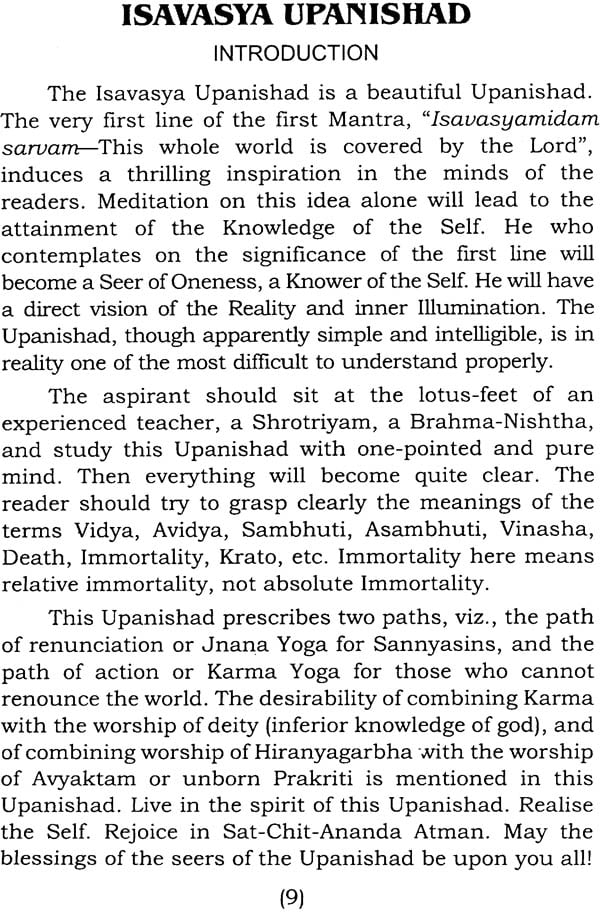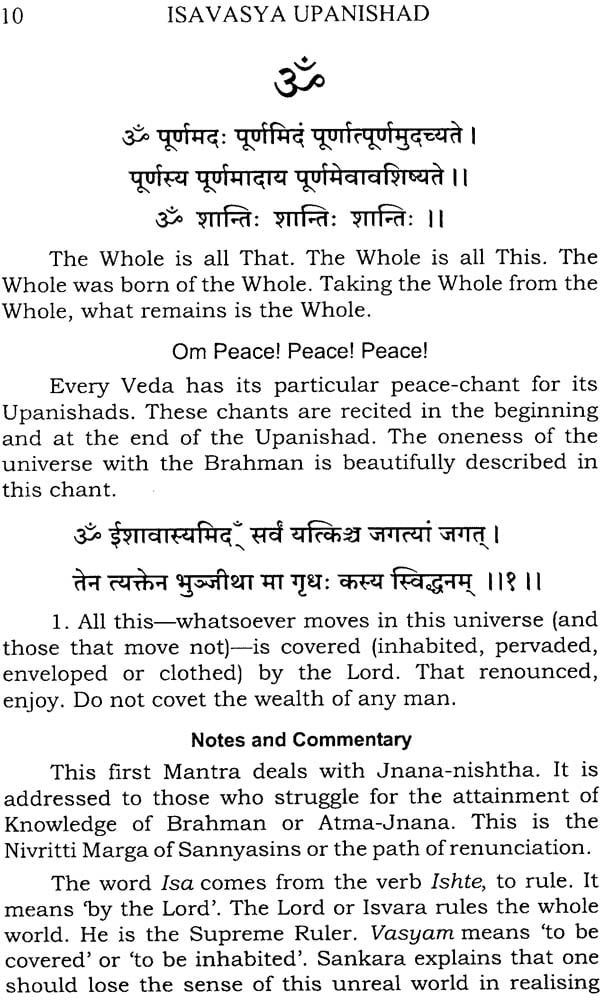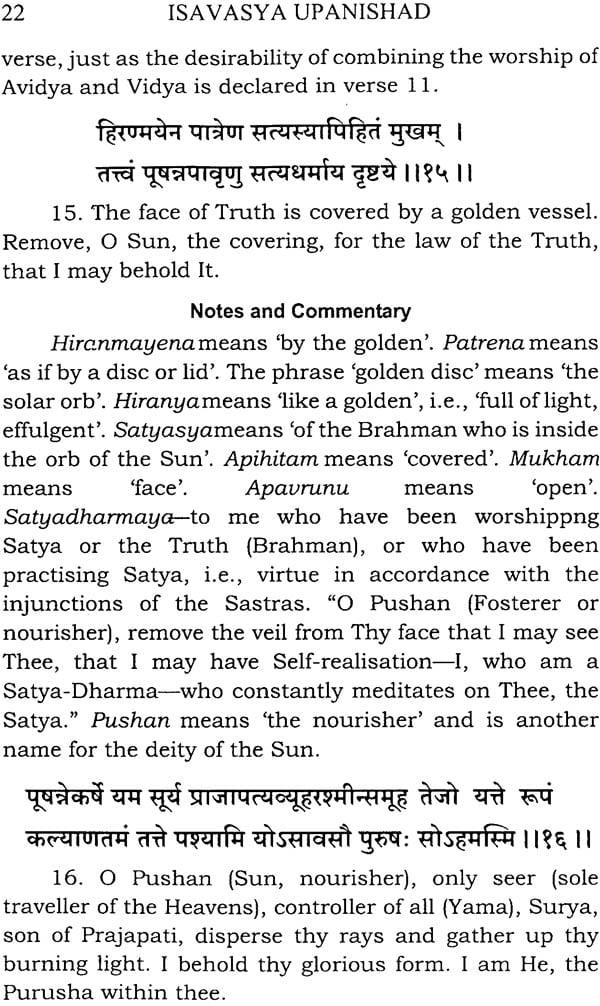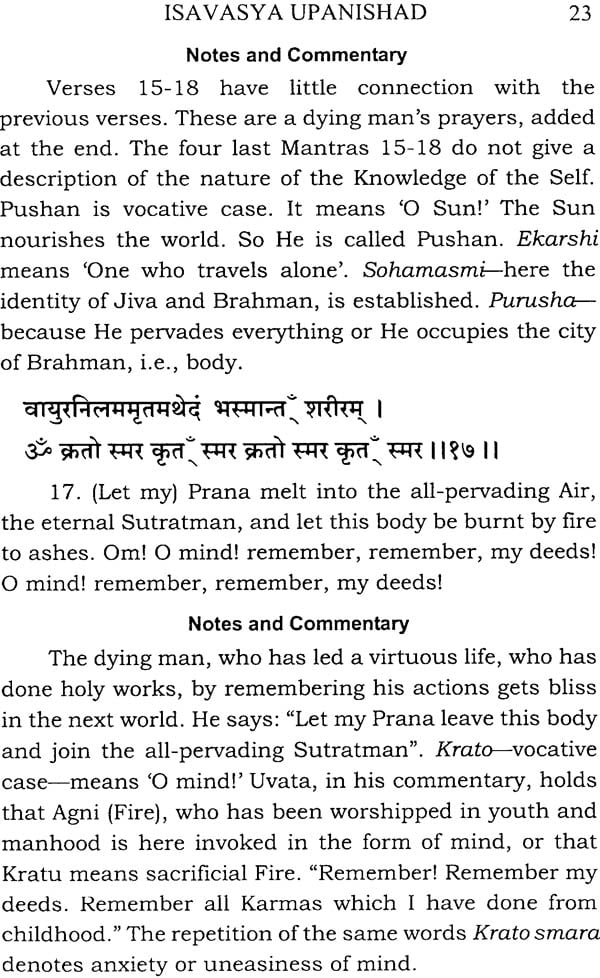
Isavasya Upanishad
Book Specification
| Item Code: | NAG690 |
| Author: | Sri Swami Sivananda |
| Publisher: | The Divine Life Society |
| Language: | Sanskrit Text With English Translation and Detailed Commentary |
| Edition: | 2013 |
| Pages: | 24 |
| Cover: | Paperback |
| Other Details | 8.5 inch X 5.5 inch |
| Weight | 50 gm |
Book Description
Publishers’ Note
The greatness and the sublimity of the Upanishads are well known to all the students of philosophy. There have been attempts to approach the books through various standpoints. Much has been written over the knotty problems of interpretation, by the Eastern and Western scholars. And yet the lay reader has not understood the central teachings fully well. Gurudev Sri Swami Sivanandaji Maharaj, in his comprehensive volume ‘The Principal Upanishads’ has given exhaustive commentary on Nine Upanishads and stressed such points clearly and truly, explaining the abstruse ideas in his own inimitable style, thus laying bare the sacred doctrine not only before the eligible pupil but also the lay reader.
For the convenience of the readers, we are bringing out each Upanishad in a separate book. The present volume contains the text, translation, notes and commentary on Isavasya Upanishad.
May the abundant blessings of Gurudev Sri Swami Sivanandaji Maharaj be upon all the readers.
Introduction
The Isavasya Upanishad is a beautiful Upanishad. The very first line of the first Mantra, “Isavasyamidam sarvam-This whole world is covered by the Lord”, induces a thrilling inspiration in the minds of the readers. Meditation on this idea alone will lead to the attainment of the Knowledge of the Self. He who contemplates on the significance of the first line will become a Seer of Oneness, a Knower of the Self. He will have a direct vision of the Reality and inner Illumination. The Upanishad, though apparently simple and intelligible, is in reality one of the most difficult to understand properly.
The aspirant should sit at the lotus-feet of an experienced teacher, a Shrotriyam, a Brahrna-Nishtha, and study this Upanishad with one-pointed and pure mind. Then everything will become quite clear. The reader should try to grasp clearly the meanings of the terms Vidya, Avidya, Sambhuti, Asambhuti, Vinasha, Death, Immortality, Krato, etc. Immortality here means relative immortality, not absolute Immortality.
This Upanishad prescribes two paths, viz., the path of renunciation or Jnana Yoga for Sannyasins, and the path of action or Karma Yoga for those who cannot renounce the world. The desirability of combining Karma with the worship of deity (inferior knowledge of god), and of combining worship of Hiranyagarbha with the worship of Avyaktam or unborn Prakriti is mentioned in this Upanishad. Live in the spirit of this Upanishad. Realise the Self. Rejoice in Sat-Chit-Ananda Atman. May the blessings of the seers of the Upanishad be upon you all!
About the Author
Born on the 8th September, 1887, in the illustrious family of Sage Appayya Dikshitar and several other renowned saints and savants, Sri Swami Sivananda had a natural flair for a life devoted to the study and practice of Vedanta. Added to this was an inborn eagerness to serve all and an innate feeling of unity with all mankind.
His passion for service drew him to the medical career; and soon he gravitated to where he thought that his service was most needed. Malaya claimed him. He had earlier been editing a health journal and wrote extensively on health problems. He discovered that people needed right knowledge most of all; dissemination of that knowledge he espoused as his own mission.
It was divine dispensation and the blessing of God upon mankind that the doctor of body and mind renounced his career and took to a life of renunciation to qualify for ministering to the soul of man. He settled down at Rishikesh in 1924, practised intense austerities and shone as a great Yogi, saint, sage and Jivanmukta.
In 1932 Swami Sivananda started the Sivanandashram. In 1936 was born The Divine Life Society. In 1948 the Yoga-Vedanta Forest Academy was organised. Dissemination of spiritual knowledge and training of people in Yoga and Vedanta were their aim and object. In 1950 Swamiji undertook a lightning tour of India and Ceylon. In 1953 Swamiji convened a ‘World Parliament of Religions’. Swamiji is the author of over 300 volumes and has disciples all over the world, belonging to all nationalities, religions and creeds. To read Swamiji’s works is to drink at the Fountain of Wisdom Supreme. On 14th July, 1963 Swamiji entered Mahasamadhi.









